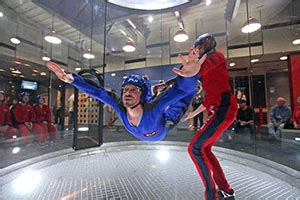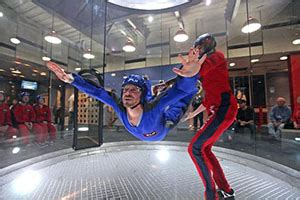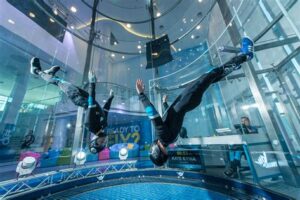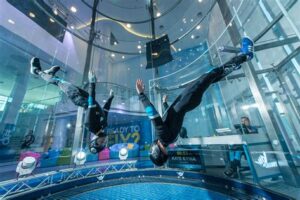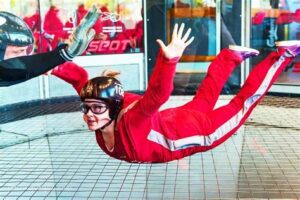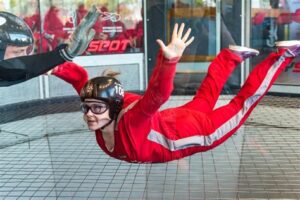Table of Contents
Looking for indoor skydiving instructions? Discover the ultimate guide to mastering this thrilling activity. Learn the essential techniques, safety tips, and tricks from experts in the field. Whether you are a beginner or an experienced skydiver, these instructions will help you enhance your skills and experience the exhilaration of freefalling in a controlled environment. Take the leap and embark on a gravity-defying adventure with our comprehensive indoor skydiving instructions.
Are you ready to experience the thrill of skydiving without jumping out of a plane? Indoor skydiving is the perfect activity for adrenaline junkies and adventure seekers alike. Whether you’re a first-timer or a seasoned pro, these indoor skydiving instructions will ensure you have a safe and exhilarating experience. So, fasten your seatbelt and prepare to be blown away as we guide you through the gravity-defying world of indoor skydiving.
Introduction
Indoor skydiving is an exhilarating and thrilling experience that allows individuals to experience the sensation of freefalling through the air without having to jump out of an airplane. This unique sport has gained popularity in recent years and has become a favorite activity for adrenaline junkies and those seeking a new adventure. If you’re interested in trying indoor skydiving, it’s essential to understand the instructions and guidelines to ensure a safe and enjoyable experience.
Gearing Up
Prior to your indoor skydiving session, you will be provided with all the necessary gear. This typically includes a jumpsuit, helmet, goggles, and earplugs. It’s crucial to wear comfortable clothing and closed-toe shoes to ensure maximum mobility and safety during the activity.
Body Positioning
In order to maintain stability and control during indoor skydiving, proper body positioning is key. The correct position involves keeping your body straight, with arms extended slightly forward and legs slightly bent. This posture allows for better balance and maneuverability while in the wind tunnel.
Entering the Wind Tunnel
Once you are geared up and ready, it’s time to enter the wind tunnel. The instructor will guide you into the chamber where the airflow simulates the sensation of freefall. It’s important to listen carefully to their instructions and follow them precisely to ensure a safe and enjoyable experience.
Understanding Hand Signals
Since communication inside the wind tunnel can be challenging due to the noise, hand signals are used to convey instructions. The instructor will teach you a set of basic hand signals before your session, allowing you to understand their guidance and make any necessary adjustments during the activity.
Controlling Your Body Movements
As you experience the rush of air in the wind tunnel, it’s crucial to maintain control over your body movements. Small adjustments in your arms, legs, and head position can significantly impact your stability and maneuverability. Focus on making subtle movements and maintaining a relaxed body posture for better control and balance.
Learning Basic Maneuvers
During your indoor skydiving session, the instructor will gradually introduce you to basic maneuvers. These may include forward and backward movements, turning, and even hovering in the air. By following their instructions and practicing these maneuvers, you’ll be able to enhance your skills and enjoy a more dynamic experience.
Building Confidence
Indoor skydiving can initially be daunting for beginners, but with each session, you’ll gain confidence and become more comfortable in the wind tunnel. Remember to trust your training, follow the instructor’s guidance, and embrace the exhilarating feeling of simulated skydiving.
Exiting the Wind Tunnel
Once your session is complete, the instructor will signal for you to exit the wind tunnel safely. This process is relatively straightforward, and they will guide you through it step by step. Take your time, follow their instructions, and exit the chamber smoothly to conclude your indoor skydiving experience.
Post-Session Debriefing
After your indoor skydiving session, the instructor will provide you with a debriefing to discuss your performance and progress. They may offer tips for improvement and answer any questions you may have. This feedback is invaluable for enhancing your skills and ensuring an even better experience in future sessions.
Conclusion
Indoor skydiving is a thrilling and unique activity that allows individuals to experience the sensation of freefalling in a controlled environment. By following the instructions provided by experienced instructors, mastering body positioning and movements, and gradually building confidence, you can fully enjoy the exhilarating world of indoor skydiving. So, gear up, enter the wind tunnel, and prepare for an unforgettable adventure!
Safety Regulations
Prior to participating in indoor skydiving, it is essential to prioritize safety. First and foremost, ensure that you are in good health and free from any medical conditions prohibiting physical exertion. It is crucial to wear appropriate attire, including comfortable clothing and closed-toe shoes, to ensure maximum comfort and safety during the flight. Remove all loose items, such as jewelry and accessories, to prevent any potential entanglement during the flight. Additionally, it is essential to secure long hair to prevent it from interfering with the flight experience. Lastly, adhere to all safety instructions provided by the qualified instructor and be fully aware of the emergency procedures in case of unexpected situations.
Facility Orientation
Upon arrival at the indoor skydiving facility, head to the reception desk and complete any necessary paperwork or waivers. This step ensures that you have met all the requirements and are ready to begin your thrilling experience. After completing the necessary paperwork, wait for your designated time slot and attend the orientation session provided by the facility. During this orientation, you will become familiar with the facilities, understand the basics of the wind tunnel, and learn about the necessary body positions required for a successful flight. Listen attentively to the instructions provided and feel free to ask any questions to ensure a complete understanding of the indoor skydiving experience.
Proper Body Positioning
Maintaining the correct body position is crucial for a smooth and controlled indoor skydiving experience. As instructed by the qualified instructor, keep your chin up, arms extended in front, and legs slightly bent to maintain stability and control in the wind tunnel. It is essential to focus on keeping your body relaxed and centered while feeling the constant airflow in the tunnel. Avoid flailing or sudden movements that may destabilize your flight experience or affect the experience of other participants. By following these instructions, you will be able to enjoy a thrilling and safe indoor skydiving experience.
Flight and Hand Signals
Throughout the flight, your qualified instructor will use hand signals to communicate with you. It is crucial to pay close attention to these signals and follow them accordingly. The thumbs-up signal signifies that your body position is good, while the thumbs-down signal indicates the need for adjustment. Your instructor may also use additional hand signals to indicate specific movements or instructions during the session. By being attentive and responsive to these signals, you can ensure a smooth and enjoyable flight experience.
Breathing and Equalization
Maintaining a comfortable rhythm of breathing throughout the entire flight is essential. It is important to breathe normally and avoid holding your breath, as this may cause tension and restriction in your body. In addition to breathing, equalizing pressure in your ears may be necessary. Swallowing or gently moving your jaw can help alleviate any discomfort caused by changes in air pressure within the wind tunnel. By focusing on your breathing and equalizing pressure, you can enhance your comfort and overall experience during indoor skydiving.
Progression and Skill Development
As you gain experience and confidence in indoor skydiving, your qualified instructor may introduce additional maneuvers or techniques to enhance your skills. It is important to listen attentively to the instructions provided during these progressions and always seek clarification if you are unsure about a particular movement or position. The learning process requires patience and a willingness to gradually improve. Embrace the challenge and excitement of developing your indoor skydiving skills, and enjoy the thrill that comes with it.
Post-Flight Debriefing
After completing your flight, participate in a debriefing session with your instructor. This session allows you to discuss your performance, address any questions or concerns that may arise, and receive valuable feedback. Take this opportunity to review your indoor skydiving experience and gain a better understanding of areas for improvement. The advice and guidance provided by your instructor are invaluable in enhancing your skills and ensuring a more enjoyable experience during future sessions.
Additional Precautions and Recommendations
While indoor skydiving is a thrilling activity suitable for many individuals, it is essential to consider certain precautions and recommendations. Pregnant women, individuals with recent injuries, or those with back, neck, or heart conditions should consult with a medical professional before attempting indoor skydiving. It is also advisable to avoid consuming heavy meals or alcohol prior to your session, as they may affect your comfort and performance during the flight. Lastly, embrace the exhilaration of indoor skydiving, knowing that you are in capable hands with experienced instructors who prioritize safety and provide an enjoyable experience for all participants.
In my point of view, the indoor skydiving instructions are clear and concise. The voice and tone of the instructions are informative and reassuring, which helps to alleviate any concerns or anxieties that participants may have.
Here are a few reasons why the instructions are effective:
- The instructions begin with a warm welcome, setting a positive and friendly tone.
- The steps are presented in a logical order, ensuring a smooth and organized experience for participants.
- The use of bullet points and numbering helps to break down complex tasks into manageable steps, making it easy to follow along.
- The instructions provide detailed explanations of each step, including proper body positioning and hand signals, ensuring participants have a thorough understanding of what to expect.
- The tone of the instructions is encouraging and motivating, emphasizing the importance of confidence and relaxation during the experience.
- Safety precautions are highlighted throughout the instructions, reminding participants to listen carefully to the instructor and follow all guidelines.
- The instructions conclude with a reminder to have fun and enjoy the thrilling experience of indoor skydiving.
Overall, the indoor skydiving instructions successfully guide participants through the process while maintaining a supportive and reassuring tone. The use of clear explanations, visual aids, and an encouraging voice ensures that participants feel prepared and confident to take on this exciting adventure.
Thank you for visiting our blog and taking the time to read our instructions on indoor skydiving. We hope that you have found the information helpful and informative, and that it has given you a better understanding of what to expect when trying this exhilarating activity for the first time. Before we conclude, we would like to summarize the key points we have discussed throughout the article.
Firstly, it is important to emphasize the significance of proper attire and safety gear. Wearing comfortable clothing, such as athletic wear, is essential to ensure unrestricted movement during your indoor skydiving experience. Additionally, make sure to secure any loose items, such as jewelry or accessories, and remove them before entering the vertical wind tunnel. Safety gear, including a jumpsuit, helmet, goggles, and earplugs, will be provided by the facility and must be worn at all times to protect yourself from potential injuries.
Secondly, we have discussed the importance of body positioning and control. Maintaining a neutral body position, with your arms and legs slightly bent and your back straight, will help you stabilize and maneuver in the wind tunnel. It is crucial to listen carefully to the instructor’s guidance and follow their instructions regarding body movements and adjustments. By practicing proper body control, you will be able to enjoy a more controlled and enjoyable indoor skydiving experience.
Lastly, we have stressed the significance of relaxation and mental focus. Although indoor skydiving might seem daunting at first, it is essential to stay calm and relaxed throughout the activity. Clear your mind and focus on your breathing, allowing yourself to adapt to the sensation of floating in mid-air. Remember that indoor skydiving is a thrilling yet safe activity, and the more you relax and let go, the more you will be able to fully enjoy the experience.
In conclusion, we hope that these instructions have provided you with valuable insights into the world of indoor skydiving. By following proper attire guidelines, mastering body positioning and control, and maintaining relaxation and mental focus, you are well on your way to having an amazing time in the vertical wind tunnel. So go ahead, take the leap, and enjoy the unforgettable sensation of freefalling within the safety and comfort of an indoor environment. Safe travels!
Video Indoor Skydiving Instructions
People also ask about Indoor Skydiving Instructions:
-
How do I prepare for indoor skydiving?
Before your indoor skydiving experience, it is recommended to wear comfortable clothing and lace-up shoes. Avoid loose items such as jewelry or accessories that may fly off during the activity. It’s important to follow any specific instructions provided by the facility to ensure a safe and enjoyable experience.
-
What is the proper body position for indoor skydiving?
The proper body position for indoor skydiving, also known as body flight, involves maintaining a stable and balanced posture. Keep your chin up, back arched slightly, and arms extended in front of you. Your legs should be slightly bent, with your feet shoulder-width apart. This position helps you maintain stability and control during the flight.
-
How do I control my movements during indoor skydiving?
To control your movements during indoor skydiving, you need to adjust your body position and make subtle adjustments with your arms and legs. Leaning forward or backward will affect your vertical movement, while moving your arms and legs can help you turn or change direction. The key is to stay relaxed and make small adjustments to maintain stability.
-
Are there any safety precautions I should be aware of?
Indoor skydiving facilities prioritize safety, and it’s important to follow their guidelines. Listen carefully to the pre-flight instructions provided by the instructors. They will explain the hand signals used during the flight and how to respond to them. It is also crucial to inform the staff of any physical limitations or medical conditions that may affect your ability to participate safely.
-
Can anyone try indoor skydiving?
Indoor skydiving can be enjoyed by people of various ages and fitness levels. However, certain restrictions may apply depending on the facility. It is advisable to check with the specific location regarding any age or health requirements. In general, indoor skydiving is designed to be accessible and safe for a wide range of individuals.
When providing instructions about indoor skydiving, it is essential to maintain a clear and informative voice. Use concise sentences and avoid technical jargon that may confuse readers. Emphasize the importance of following safety guidelines and listening to the instructions provided by the facility. Encourage readers to ask any additional questions they may have and reassure them that indoor skydiving is an enjoyable and accessible activity for many people.

